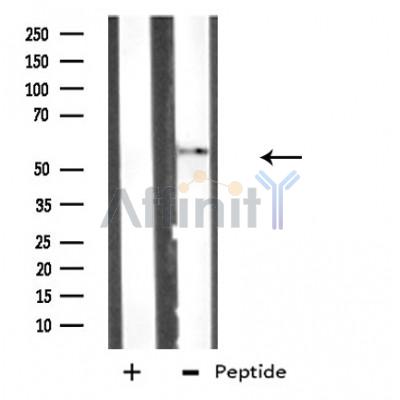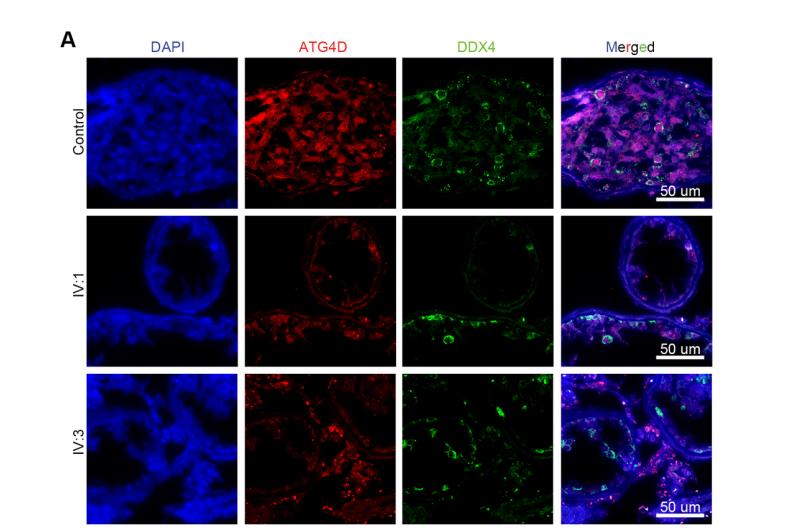ATG4D Antibody - #DF3977
製品説明
*The optimal dilutions should be determined by the end user.
*Tips:
WB: For western blot detection of denatured protein samples. IHC: For immunohistochemical detection of paraffin sections (IHC-p) or frozen sections (IHC-f) of tissue samples. IF/ICC: For immunofluorescence detection of cell samples. ELISA(peptide): For ELISA detection of antigenic peptide.
引用形式: Affinity Biosciences Cat# DF3977, RRID:AB_2836337.
折りたたみ/展開
9830134P12Rik; APG4 autophagy 4 homolog D; APG4 D; APG4, S. cerevisiae, homolog of, D; APG4D; ATG4 autophagy related 4 homolog D (S. cerevisiae); Atg4d; ATG4D_HUMAN; Atg4dl; AUT like 4 cysteine endopeptidase; AUT-like 4 cysteine endopeptidase; AUTL4; Autophagin 4; Autophagin-4; autophagy 4, S. cerevisiae, homolog of, D; autophagy related 4D, cysteine peptidase; Autophagy related cysteine endopeptidase 4; Autophagy related protein 4 homolog D; Autophagy-related cysteine endopeptidase 4; Autophagy-related protein 4 homolog D; Cysteine protease ATG4D; Cysteine protease involved in autophagy; MGC31226;
免疫原
A synthesized peptide derived from human ATG4D, corresponding to a region within C-terminal amino acids.
- Q86TL0 ATG4D_HUMAN:
- Protein BLAST With
- NCBI/
- ExPASy/
- Uniprot
MNSVSPAAAQYRSSSPEDARRRPEARRPRGPRGPDPNGLGPSGASGPALGSPGAGPSEPDEVDKFKAKFLTAWNNVKYGWVVKSRTSFSKISSIHLCGRRYRFEGEGDIQRFQRDFVSRLWLTYRRDFPPLPGGCLTSDCGWGCMLRSGQMMLAQGLLLHFLPRDWTWAEGMGLGPPELSGSASPSRYHGPARWMPPRWAQGAPELEQERRHRQIVSWFADHPRAPFGLHRLVELGQSSGKKAGDWYGPSLVAHILRKAVESCSDVTRLVVYVSQDCTVYKADVARLVARPDPTAEWKSVVILVPVRLGGETLNPVYVPCVKELLRCELCLGIMGGKPRHSLYFIGYQDDFLLYLDPHYCQPTVDVSQADFPLESFHCTSPRKMAFAKMDPSCTVGFYAGDRKEFETLCSELTRVLSSSSATERYPMFTLAEGHAQDHSLDDLCSQLAQPTLRLPRTGRLLRAKRPSSEDFVFL
種類予測
Score>80(red) has high confidence and is suggested to be used for WB detection. *The prediction model is mainly based on the alignment of immunogen sequences, the results are for reference only, not as the basis of quality assurance.
High(score>80) Medium(80>score>50) Low(score<50) No confidence
研究背景
Cysteine protease required for the cytoplasm to vacuole transport (Cvt) and autophagy. Cleaves the C-terminal amino acid of ATG8 family proteins MAP1LC3 and GABARAPL2, to reveal a C-terminal glycine. Exposure of the glycine at the C-terminus is essential for ATG8 proteins conjugation to phosphatidylethanolamine (PE) and insertion to membranes, which is necessary for autophagy. Has also an activity of delipidating enzyme for the PE-conjugated forms.
Plays a role as an autophagy regulator that links mitochondrial dysfunction with apoptosis. The mitochondrial import of ATG4D during cellular stress and differentiation may play important roles in the regulation of mitochondrial physiology, ROS, mitophagy and cell viability.
Cleaved by CASP3 during apoptosis which leads to increased activity. The cleavage by CASP3 reveals a cryptic mitochondrial targeting sequence immediately downstream of their canonical caspase cleavage sites which leads to mitochondrial import of the protein.
Cytoplasm.
Cytoplasm. Mitochondrion matrix.
Note: Imported into mitochondrial matrix after cleavage by CASP3 during oxidative stress and cell death.
Mainly expressed in skeletal muscle and, to a lower extent, in testis.
Residues 64 to 103 constitute a cryptic mitochondrial transit peptide which is revealed after cleavage by caspase of residues 1 to 63 upon oxidative stress and cell death. It acts then as a functional transit peptide, and allows the import of the cleaved protein into the mitochondria (PubMed:22441018).
Belongs to the peptidase C54 family.
研究領域
· Cellular Processes > Transport and catabolism > Autophagy - other. (View pathway)
· Cellular Processes > Transport and catabolism > Autophagy - animal. (View pathway)
参考文献
Application: IF/ICC Species: Human Sample: testicular tissue
Restrictive clause
Affinity Biosciences tests all products strictly. Citations are provided as a resource for additional applications that have not been validated by Affinity Biosciences. Please choose the appropriate format for each application and consult Materials and Methods sections for additional details about the use of any product in these publications.
For Research Use Only.
Not for use in diagnostic or therapeutic procedures. Not for resale. Not for distribution without written consent. Affinity Biosciences will not be held responsible for patent infringement or other violations that may occur with the use of our products. Affinity Biosciences, Affinity Biosciences Logo and all other trademarks are the property of Affinity Biosciences LTD.


